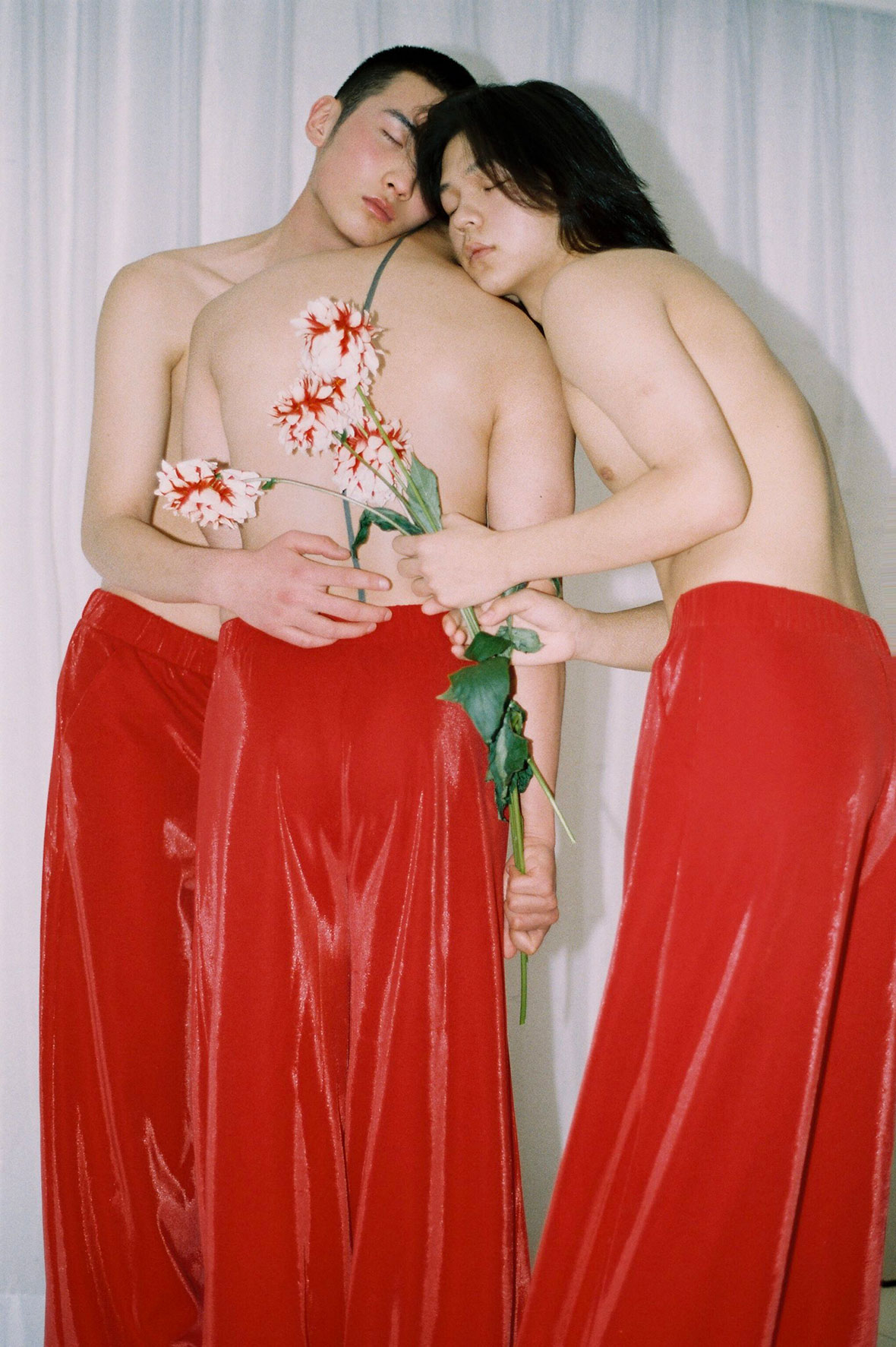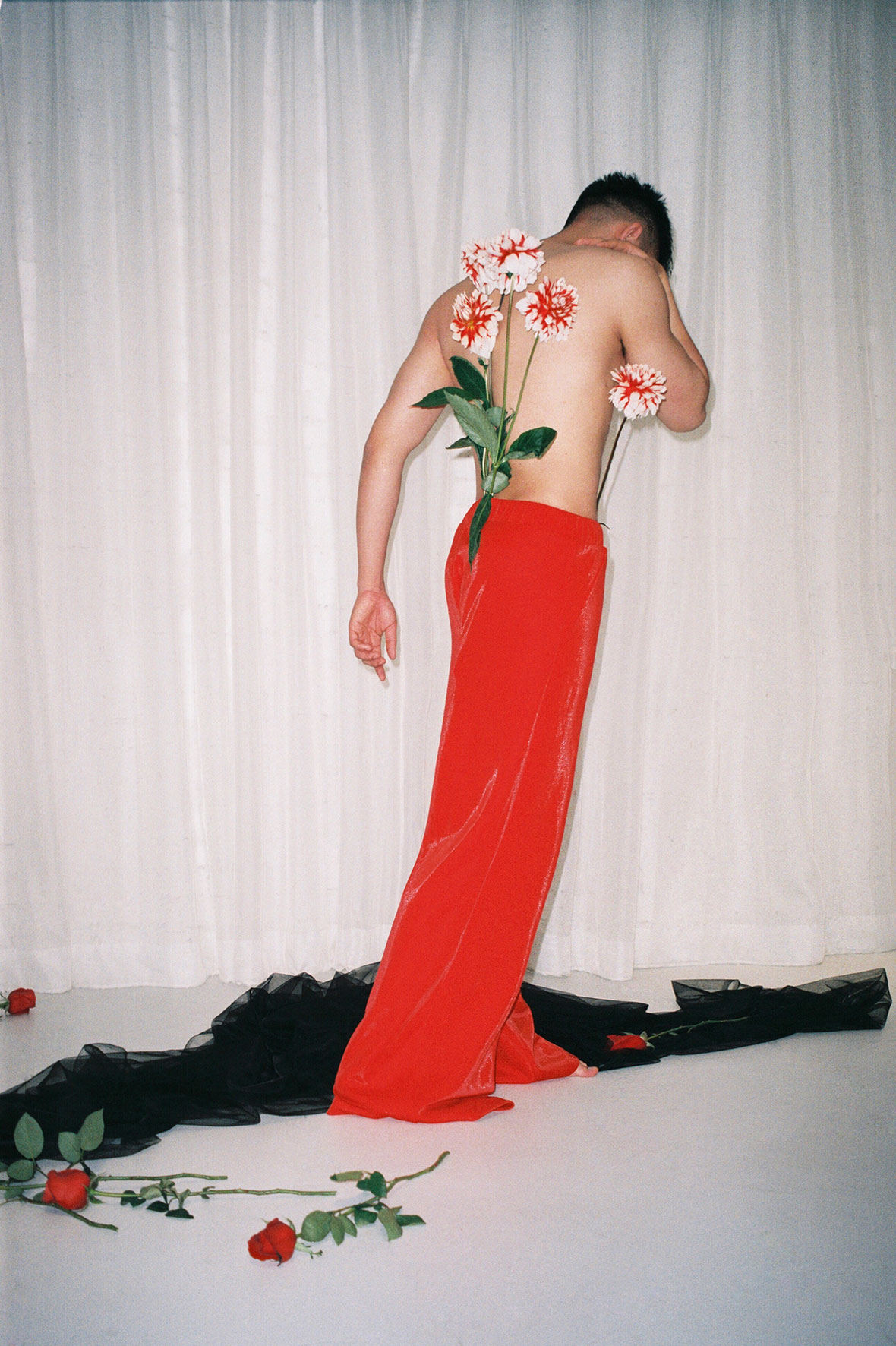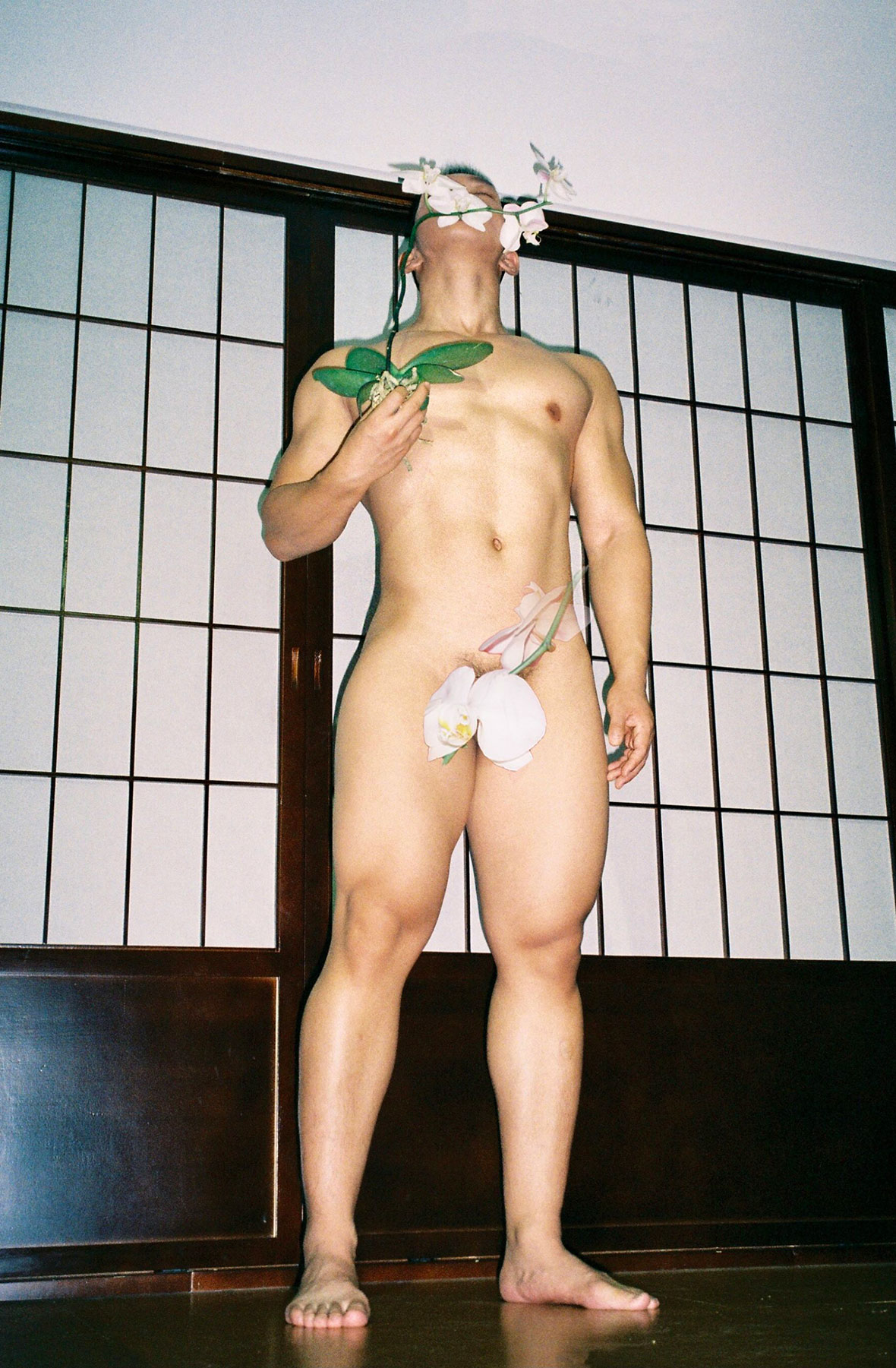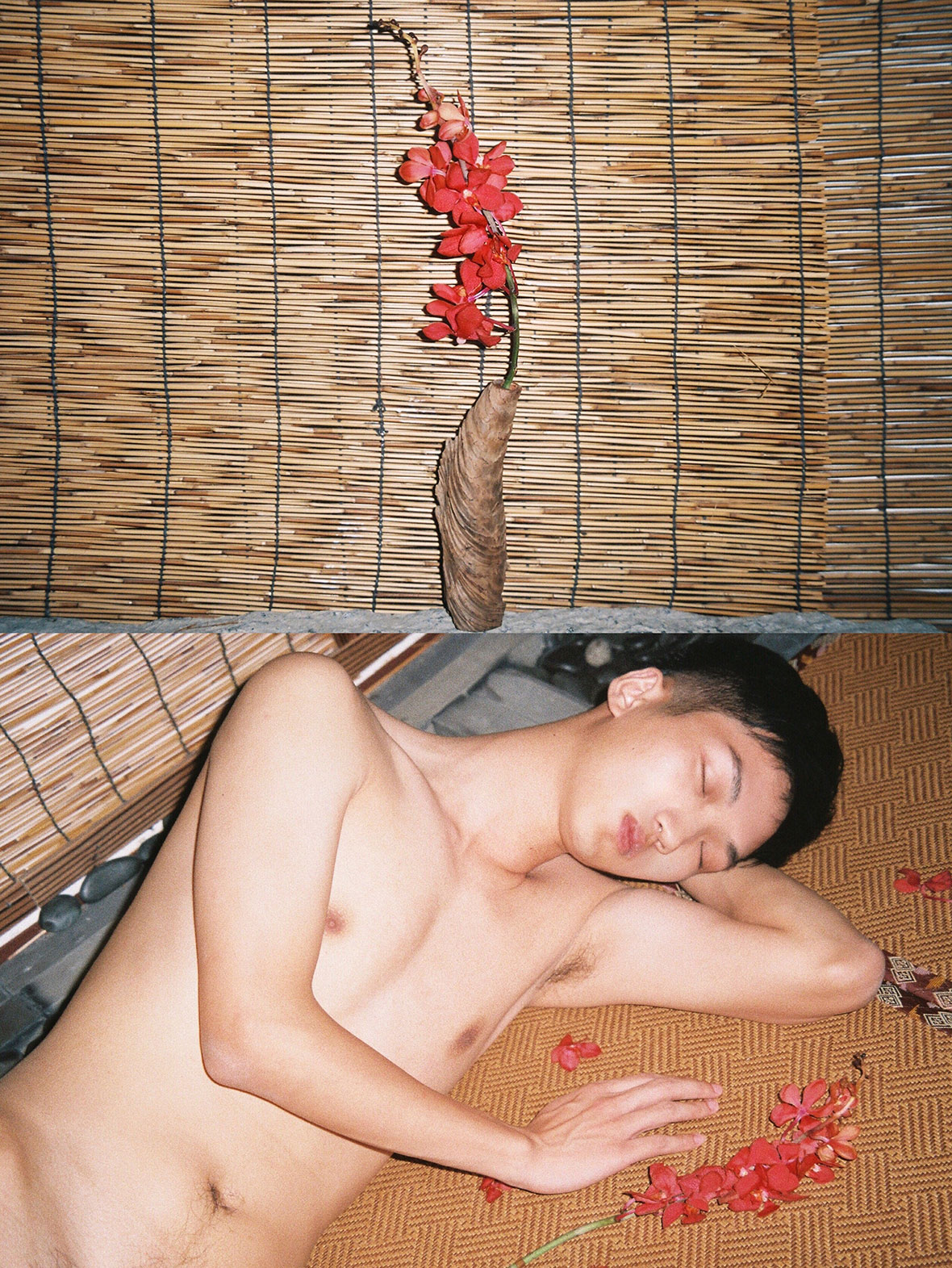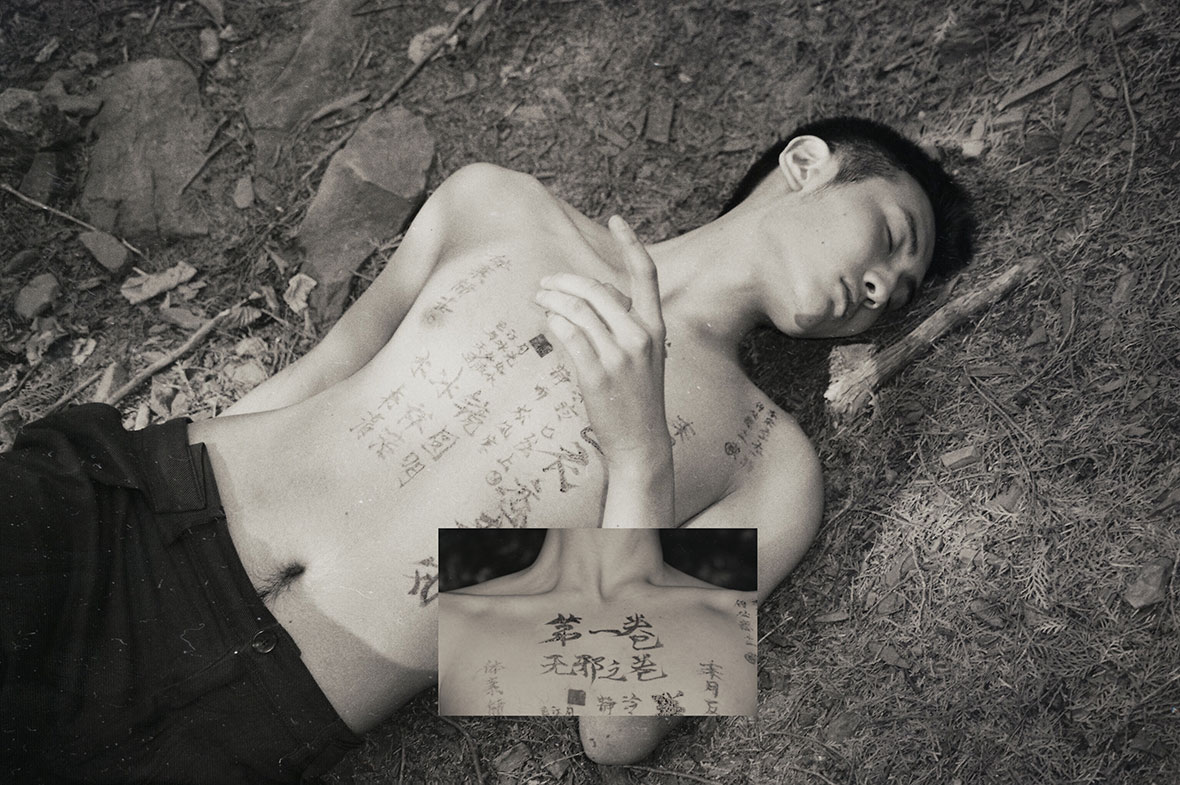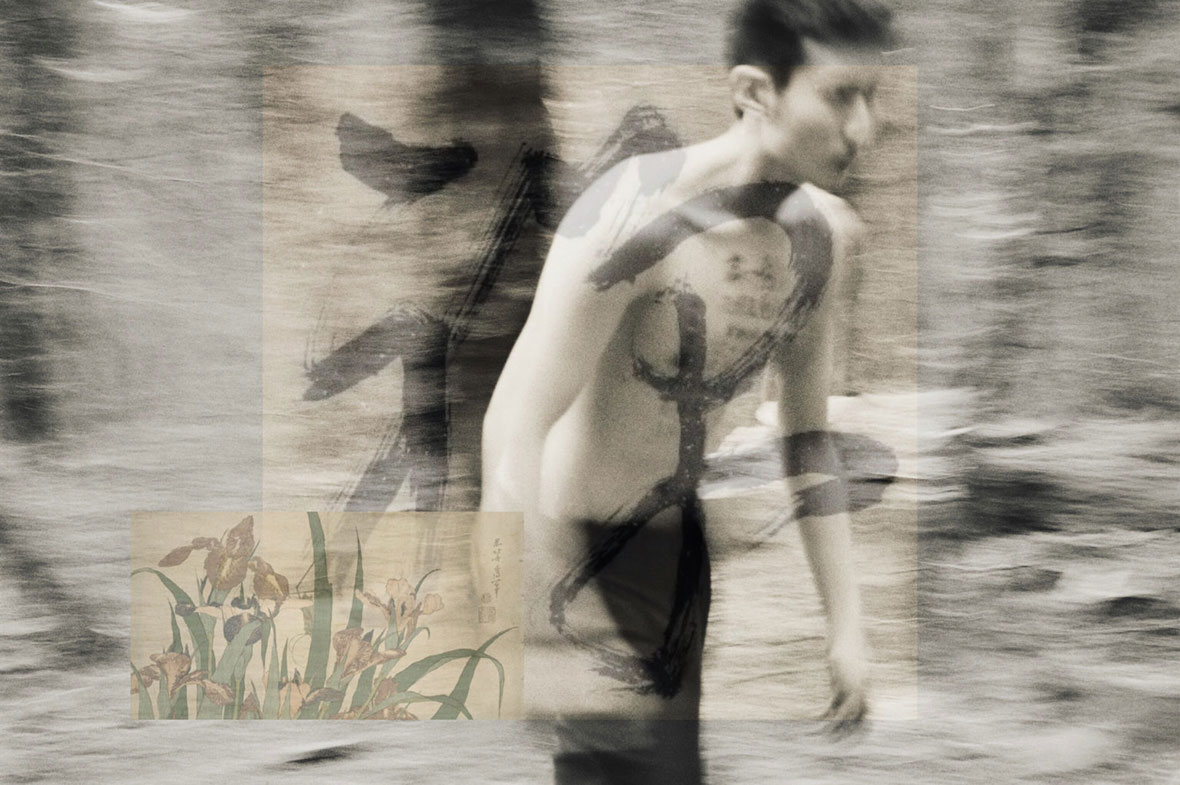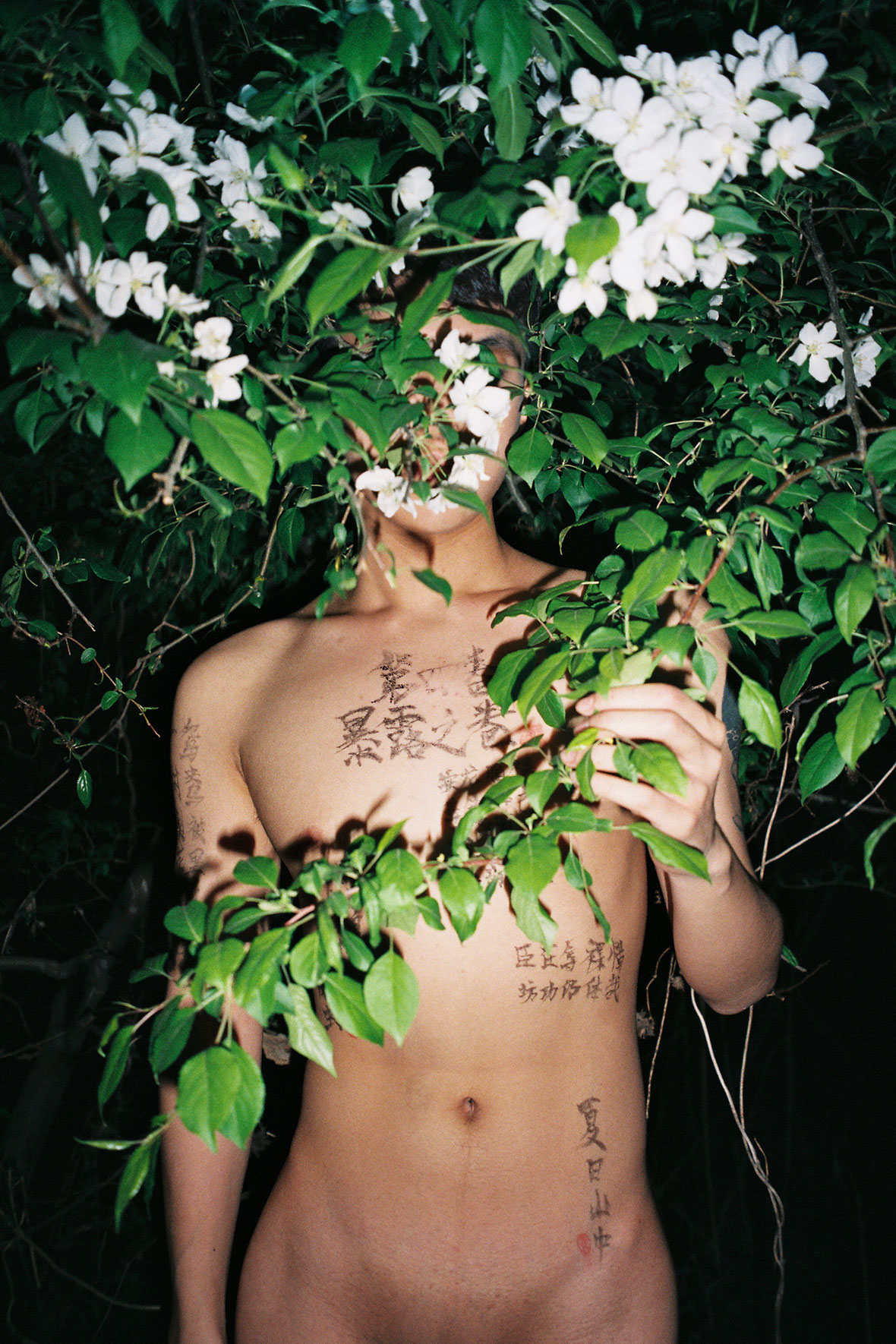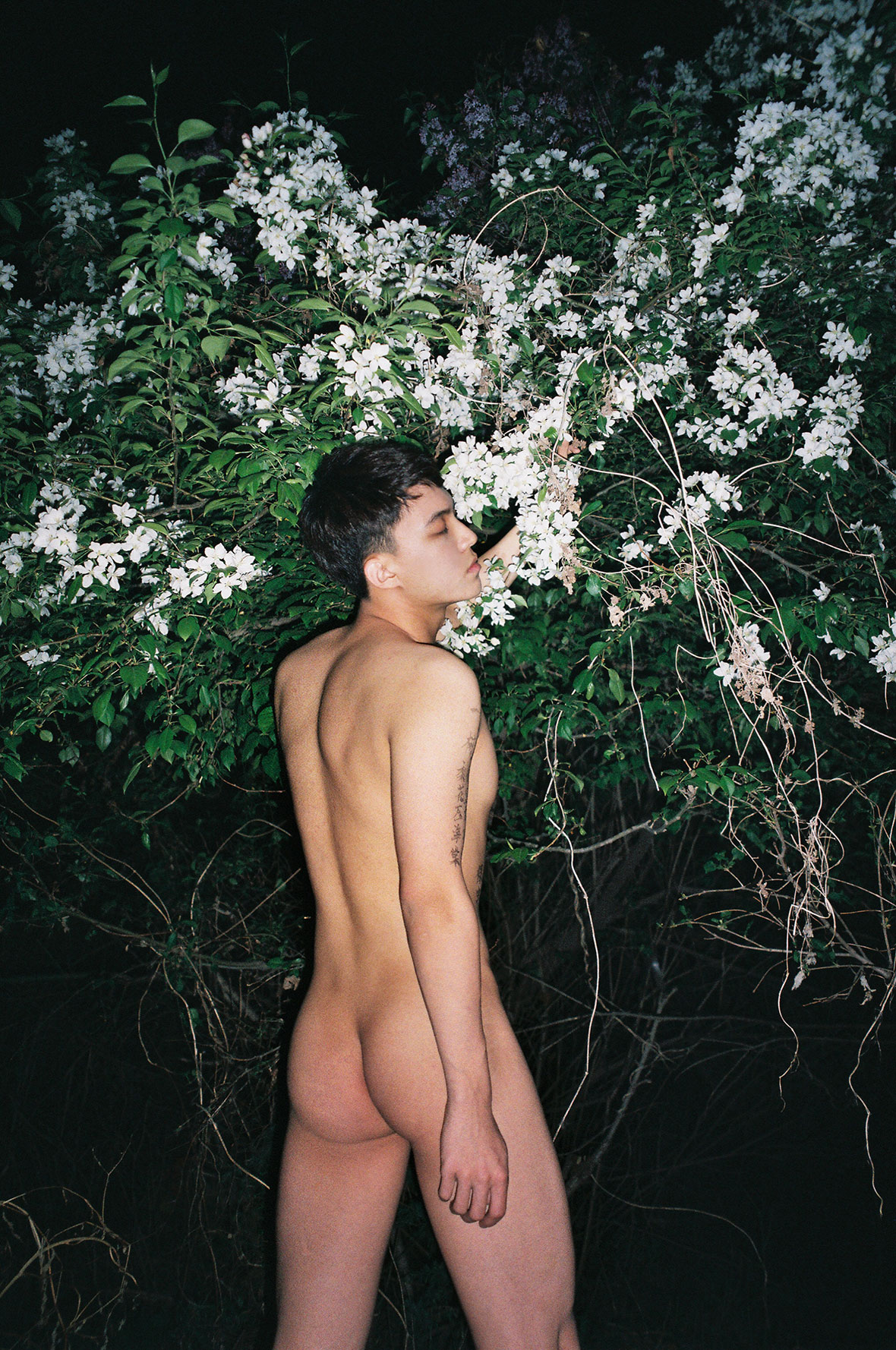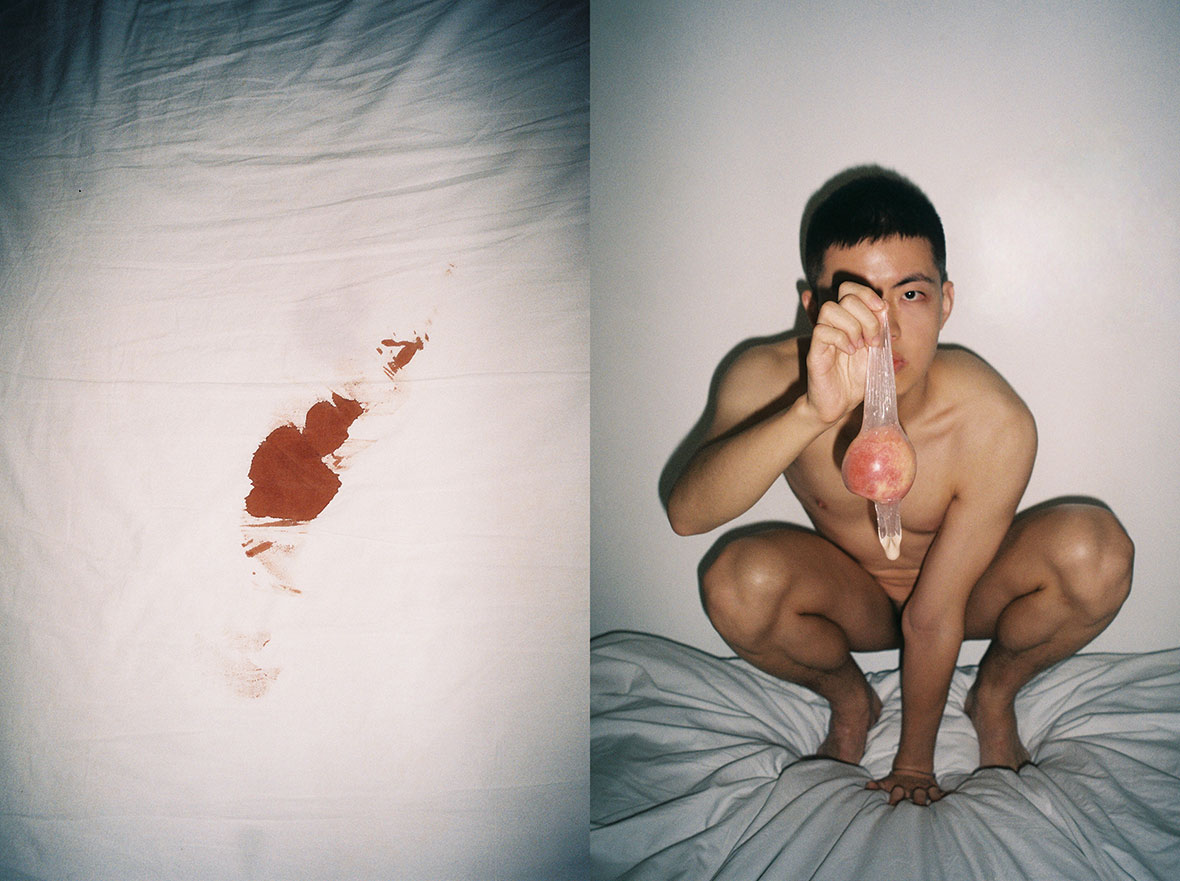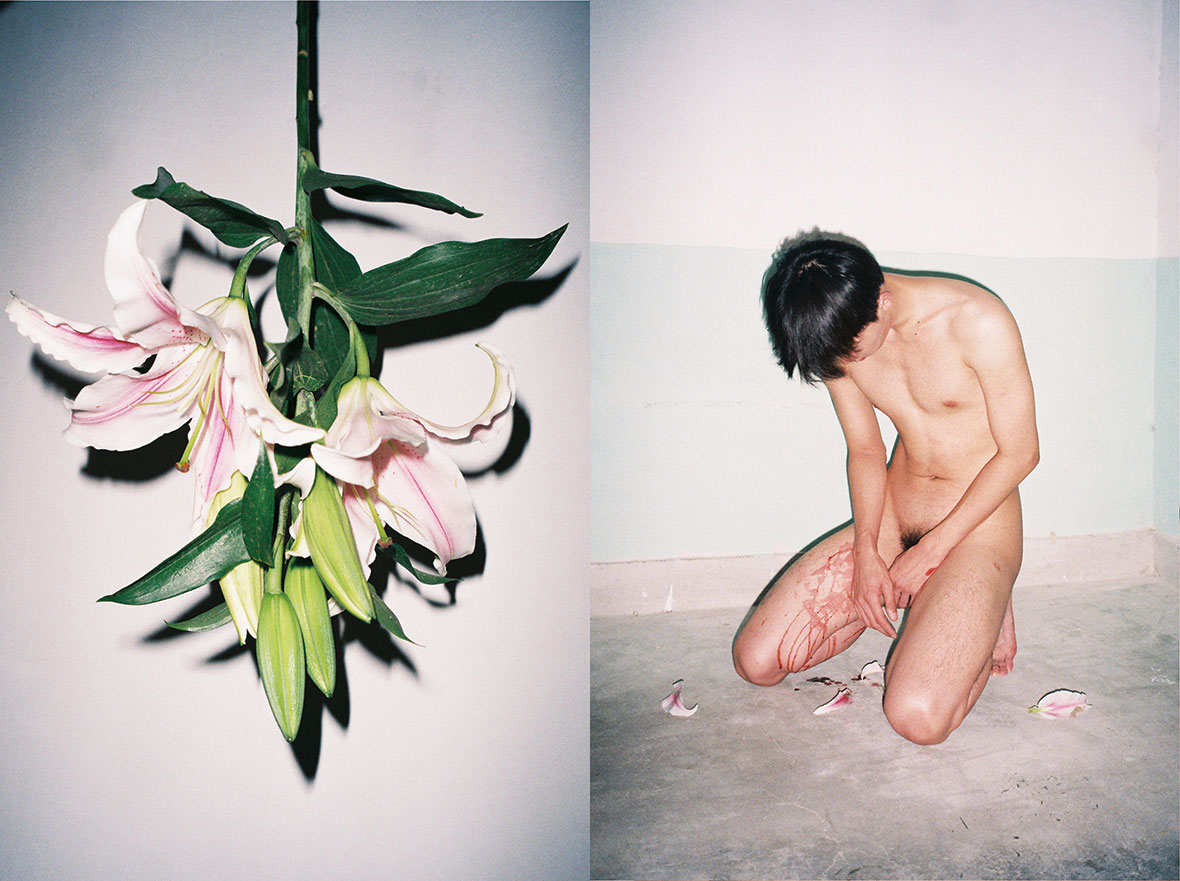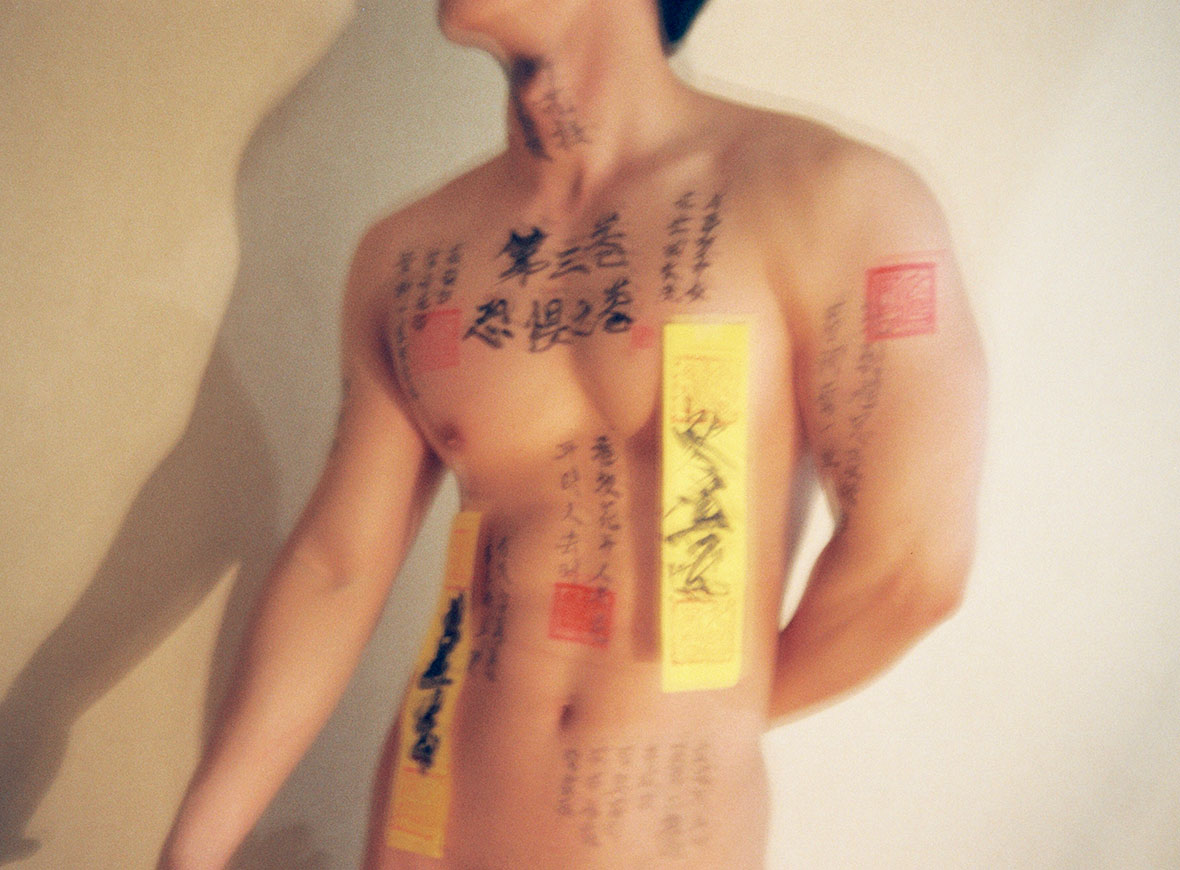
What do carnal desire and artistic expression have in common? To Beijing-based photographer Shengzhe, everything. Both can arouse strong feelings in people, often sensations of the flesh that make no sense if put into words. “Maybe art is something with a strong sense of form, something that makes people feel. But if we have to explain it, it’s nonsense,” he says.
These powerful yet undefinable feelings are what prompted Shengzhe to create his erotic photographic series of attractive young men with their nude bodies on view and engaging in a variety of sexual fantasies. Through these photographs, he wants to break with the still prevailing old-fashioned morality and show people that sexuality is something as natural as breathing. Shengzhe’s photos blur the lines between what’s artistically pleasing and sensually arousing—and they most definitely hit the senses hard.
究竟如何用艺术来表达人类肉欲?对于北京摄影师圣喆来说,二者几乎属于同一种事物,都能唤起人的强烈感受——是难以言表的感官体验。圣喆说:“也许艺术就是具有强烈形式感的东西,是让人们产生感受的事物。但当我们试图去解释艺术时,它就已经失去了意义。”
这种强烈而又难以被定义的感受,促使圣喆进行情色摄影系列的创作。在他的作品里,迷人的年轻男子被包裹在天花乱坠的性幻想中,他们尽情地展现自己的裸露身体,乐在其中。圣喆想通过作品打破眼下依然盛行于世的传统道德观,渴望向人们证明:性,是如同呼吸一样自然的存在。而与此同时,他的作品兼具艺术观赏性和强烈的感官冲击力。
Shengzhe only photographs men. Single or coupled, his models appear fully undressed, involved in erotic narratives. However, we rarely see their sexual parts fully exposed in the photographs. Shengzhe covers them with props during shooting or, in post-editing, with image cutouts that vary from flower stems to snakes that wrap around their groins. Still, he leaves their pubic hair suggestively exposed and reveals parts of the male genitalia.
Both the sculptural nudity of Shengzhe’s works and their youthful quality remind of the photographs of late Chinese artist Ren Hang. Likewise, Shengzhe’s work sometimes also bears the same provocative quality as the photography of Nobuyoshi Araki, mainly because of its recurrent bondage elements, the flowers he uses as props, and the tatami rooms settings.
圣喆只拍男人。他镜头下的模特,无论单身还是已有伴侣,都会裸体出镜,沉浸在这桃色情节之中。圣喆很少完全展现模特的隐私部位,而是换作道具遮盖,或者后期剪辑中用其他图片覆盖,比如在模特的腹股沟上放置一张花茎或蛇的图片。不过,他还是选择让模特的阴毛带有暗示性地露出,以此作为男性私处的一部分。
圣喆作品中那些雕塑般的裸体肖像和随之散发的年轻气质,很容易让人联想到已故中国艺术家任航的作品;而反复出现的捆绑元素、花朵道具和榻榻米陈设,又像是荒木经惟似的,极具挑逗性。
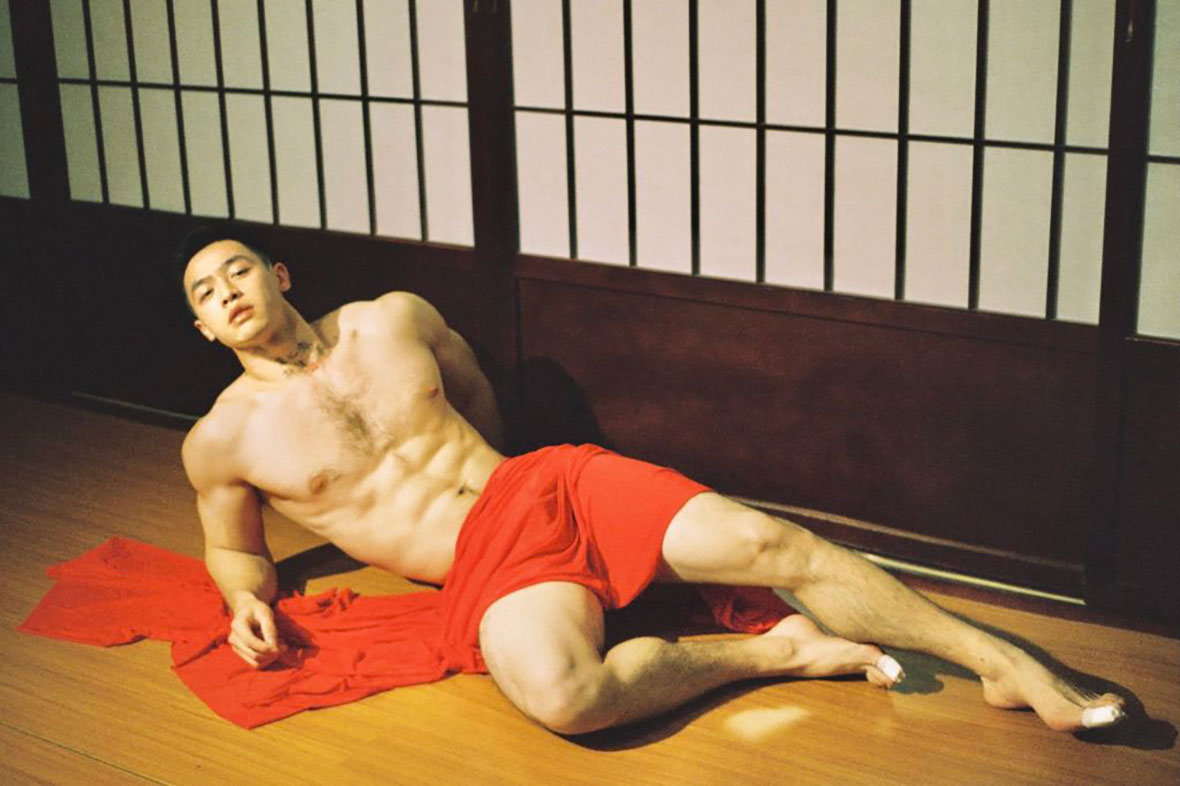
Japanese motifs are recurrent in Shengzhe’s oeuvre. In Welcome to Tokyo, an anthology of Japanese-themed works, we see many cultural nods such as Noh masks and katanas, as well as architectural features like tatami mats and shoji screens composing the mise-en-scène. Still, his scope of references goes beyond the obvious: Shengzhe also overlays images of ancient poems and shunga, Japanese erotic art, into some of his photographs. He is drawn to Japanese art as a whole, particularly vintage films, animes, and photography—and he’s especially thrilled when he finds sexual innuendos hidden in them. “Metaphorical sexual desire emerging from a strict cold shell fascinates me,” he says.
日本元素在圣喆的作品中频频出现。在以日本为主题的系列作品《欢迎来到东京》中,能乐面具(のうがく)、武士刀,榻榻米垫、屏风等日本装饰元素纷纷亮相。而圣喆所参考的日本元素远不止这些,他还在一些作品中加入日本古诗和“春画”。他承认自己痴迷于日本艺术,尤其是一些日本老电影、动画和摄影。每当他发现艺术作品出现隐藏的性暗示时,他都格外兴奋:“从严肃冰冷的表象背后浮现出关于性欲望的隐喻,往往让我着迷。”
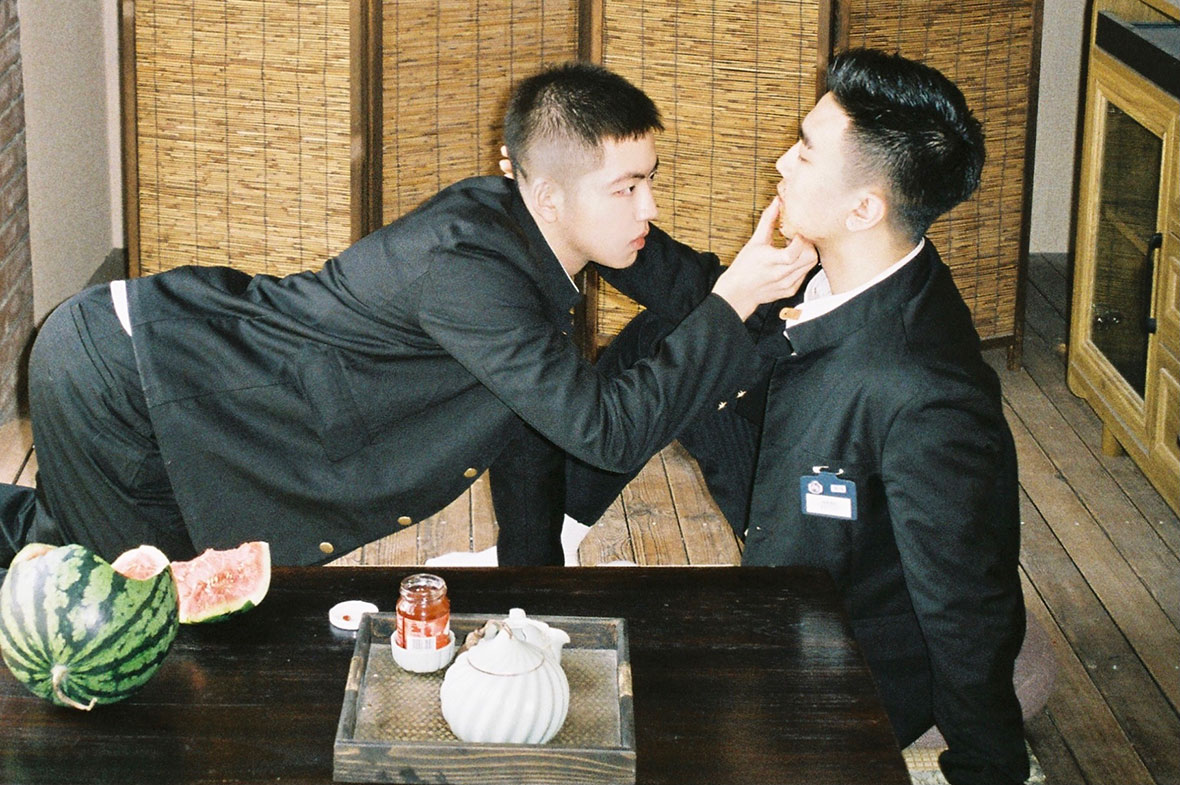
Naturally, Shengzhe maximizes any sexually suggestive marker in his work almost to a full extent. One of his most luscious series is “Spring Dream,” which is part of Welcome to Tokyo. In it, he presents a narrative about a boy who has an erotic dream about a flower stem he keeps at home. In the dream, the flower transmutes into a magical being with a male body: the flower God. What ensues is that both of them engage in a theatrical sexual fable, trying several positions in a tatami room. The boy appears with his eyes closed in every photo, and it looks as though he’s still asleep throughout the entire act, even when he bends forward or sits on top of his partner. The latter is very awake—in every sense of the word.
渐渐地,性暗示元素在圣喆的作品中被极大地扩散开来。《欢迎来到东京》作品集中的《春梦》系列,是他最情色的系列之一,讲述了男孩对家中花朵枝茎产生性幻想的经历。梦里,花朵的形象愈发神奇,逐渐幻化为一位男性的身体——在作品中被称之为花神。花神和男孩在榻榻米房间尝试不同体位,仿佛演绎了一场极具戏剧性的性爱寓言。在该系列所有作品中,男孩的双眼始终紧闭,告诉观众——眼前的一切皆是梦境。
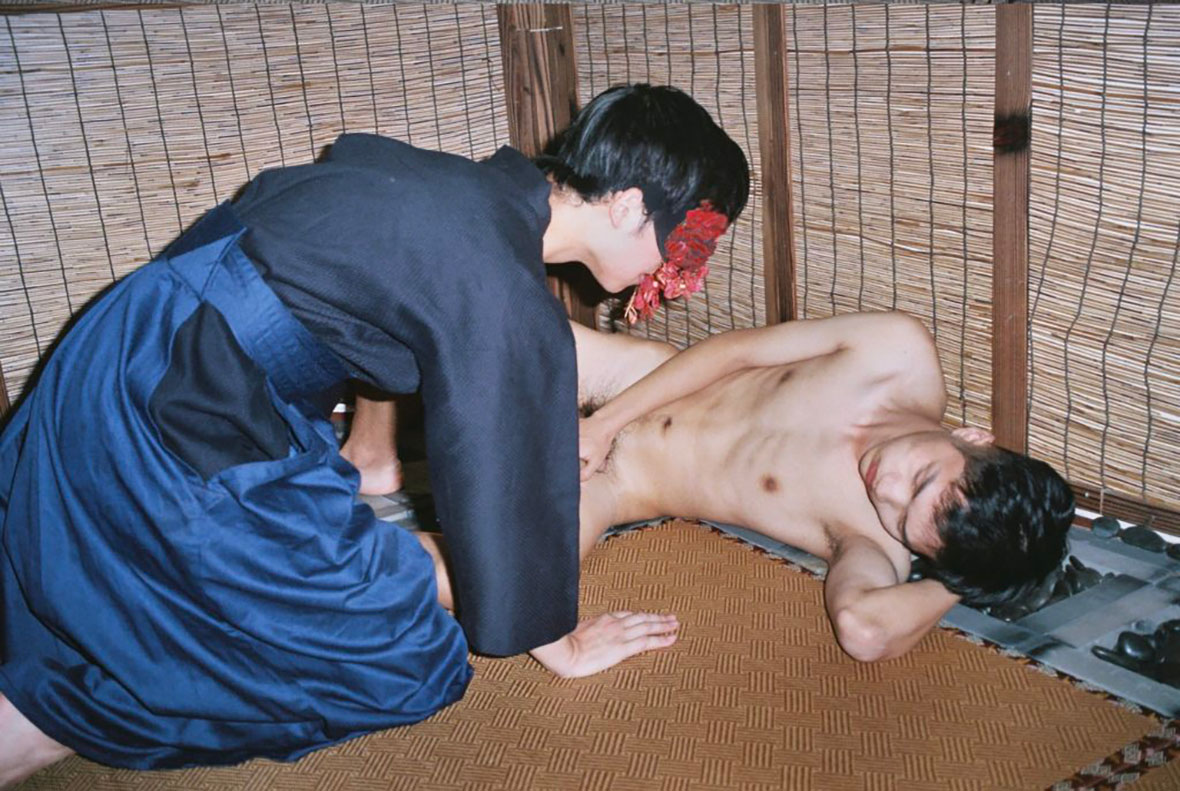

The allegory of the flower relates directly to the shunga images he superimposes on some photos in this series. Meaning “spring pictures” in Japanese, shunga books, handscrolls, and prints were very popular, and even mainstream, during the Edo period in Japan, between 1603 and 1867. They were illustrations of highly explicit sexual scenes depicted unashamedly, portraying sex as something normal, inseparable from life. These illustrations often included group and homosexual sex, and some depict men dressed as geishas having sex with other men.
Despite the common belief that humanity has grown less conservative over time, during this period at least, Japanese society seemed to have had a much more uninhibited attitude towards sex; shunga was even a common gift to exchange amongst the upper classes.
Social inhibition regarding sex is what Shengzhe aims to change with his work. He wants to expand the boundaries in people’s minds, normalize discussions, and break the taboos that modern life has attached to sexuality. “Sexual innuendoes are very true to life, ordinary intentions,” he says. “Ironically, the scientific and technological progress we’ve seen through time is far greater than the actual progress of our ways of thinking and attitudes,” he adds.
这组关于“花的寓言”系列与古老的“春宫图”(Shunga,又称“春画”)具有直接关联。日本江户时代,“春画”曾十分盛行,甚至一度成为主流。当时的春画册、卷轴书还有版画中出现,充斥了高度露骨的性爱场景,赤裸裸地将性描绘成生活中稀松平常、不可或缺之事。这些绘画中,群体性行为和同性性行实属常见,其中不乏有很多打扮成艺妓的男性与其他男性发生性关系的场景。而在中国,最早的“春宫图”甚至可以追溯至汉代,直至清代。
尽管大众普遍认为,随着时代的推进,人类的价值观变得更加开放。但江户时代的日本社会对性的态度,和今昔比起来,反倒是有过之而无不及——“春画” 在当时甚至一度成为上流人士间的互赠礼品。
圣喆想要通过创作来改变社会“性压抑”的观念,打破人们思想的边界;他希望人们把关于性的讨论正常化,打破现代生活赋予性的禁忌。他说:“人们对‘性’的看法极大程度上反映了现实,以及生而为人最为普世的意向。但人的思维方式和观念的转变,远不及科学技术的进步,这颇为讽刺。”
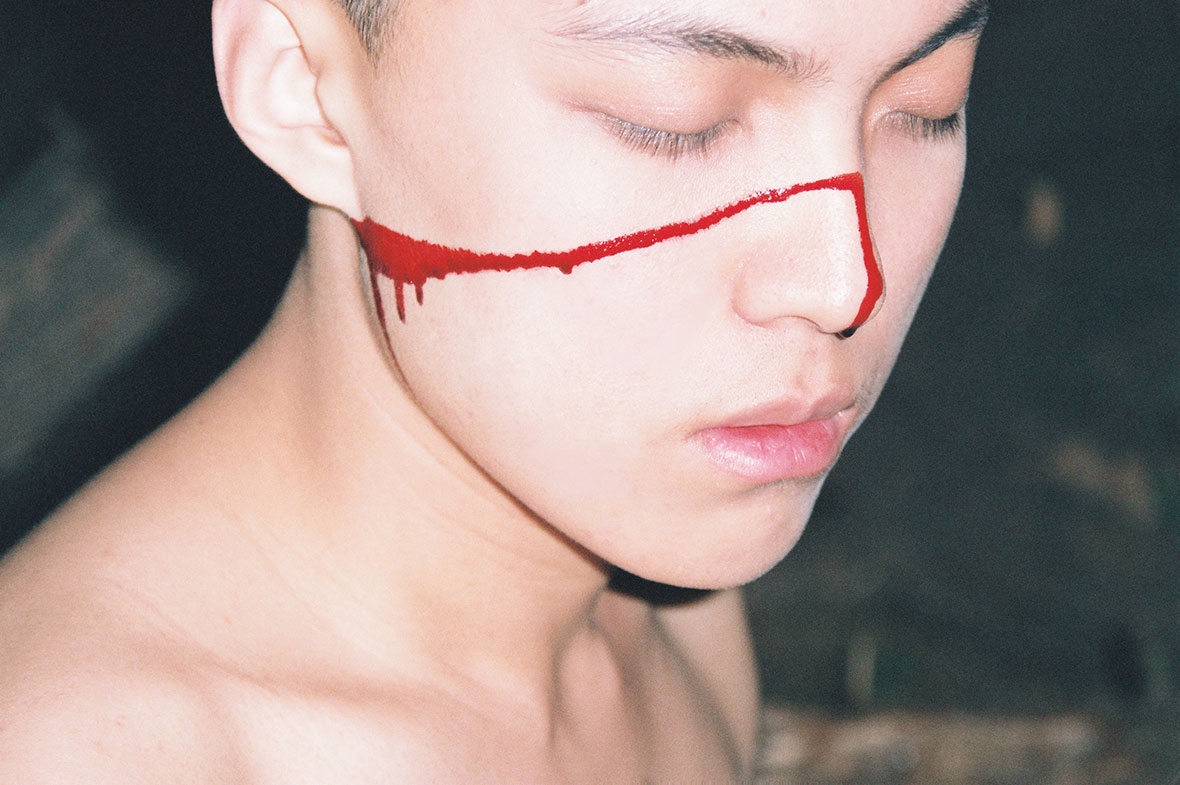
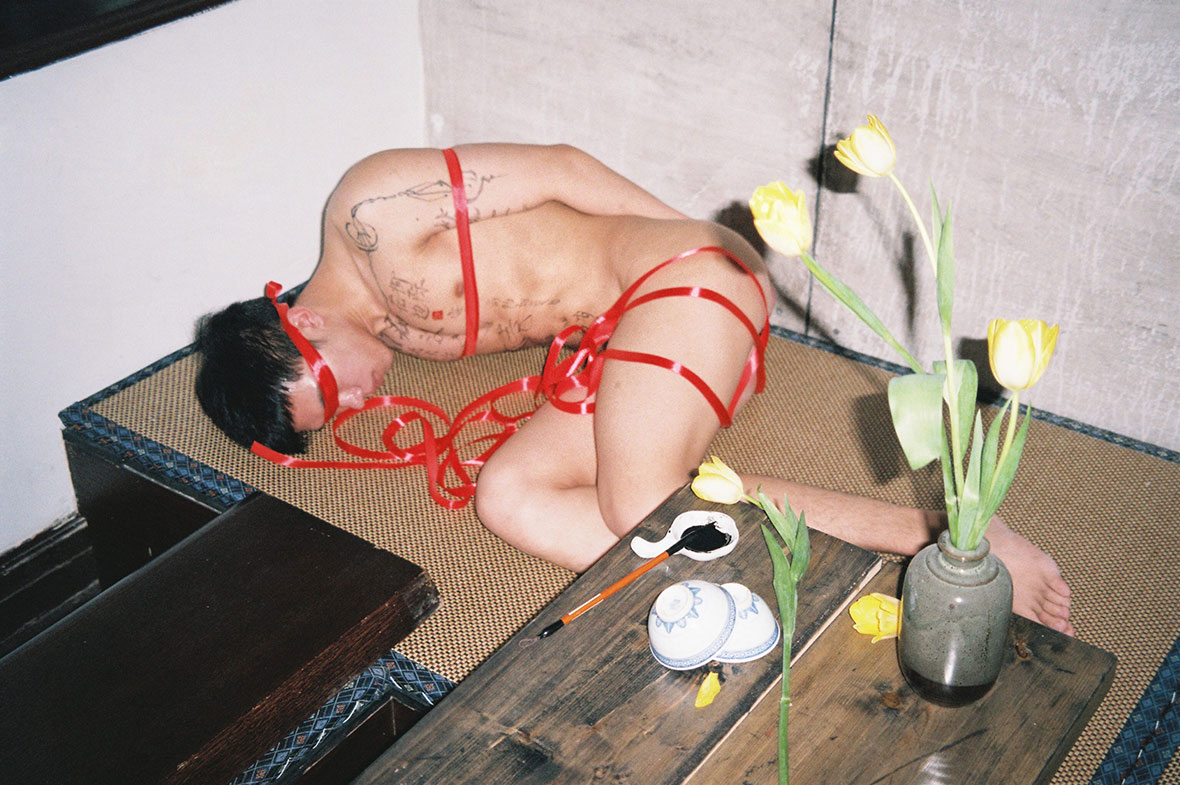
Still, there’s yet another reason Shengzhe juxtaposes shunga imagery—and poems, for that matter—with his erotic photographs. It’s something he borrows from his idol, film director Peter Greenaway, and more precisely from Greenaway’s 1996 visually striking erotic drama, The Pillow Book.
The inherent foreignness and exoticism of the film is something that fascinates Shengzhe. Unlike many people, he actually appreciates when oriental themes are represented through Western gazes in cinema. He says there’s always a certain strangeness that occurs without conscious intent—and that’s what he finds appealing.
Greenaway is known for betting on the power of images and sound to tell stories, often to the detriment of a more elaborate or even gripping narrative. His work is influenced by Baroque, Renaissance, and Flemish paintings, and his films often resemble compositions from such periods. More than entertaining, Greenaway’s films have the power to move people and make them feel things—sometimes things they can’t describe. “After watching [The Pillow Book], I felt something wonderful, strange, and unreal. I was deeply fascinated by it,” Shengzhe says.
His fascination with the film led him to create a homonymous series composed of his own short film and several photographs. It’s an homage to Greenaway’s masterpiece, a personal rendition where he reclaims many of the director’s trademark elements. For instance, Shengzhe’s film begins with a dramatic voice-over narration reciting the same monologue that echoes throughout the film in various scenes. Also, such as Greenaway, Shengzhe uses overlapping images that play simultaneously. They’re both a stylistic device and a means to add extra layers of meaning to the story. Other stylistic devices he borrows are the combination of black and white with color and retro effects.
除此之外,圣喆的创作灵感还有一部分来源于英国导演彼得·格林纳威(Peter Greenaway)。更准确地说,是这位导演在 1996 年拍摄完成的电影《枕边书》(The Pillow Book)。影片探讨了同性以及两性关系中的权力失衡问题。片中的人物以人体为纸稿进行书写,在当时极具视觉冲击力。
电影中对东方图景的独到刻画让圣喆为之着迷。圣喆很欣赏这种以西方视角描绘东方主题的拍摄手法。他认为,这种方式总能在无意间给观众一种疏离、陌生感,这也正是吸引他的地方。
虽然格林纳威的影片并未做到叙事详尽、也没有扣人心弦的情节,但在视听方面,却令人震撼。受巴洛克、文艺复兴和佛兰德绘画的影响,这些时期的作品常被格林纳威融入进电影中。他的作品兼具娱乐性和冲击力,引发观众丰富的感官体验。圣喆说:“看完《枕边书》后,我的大脑感受到一种奇妙、陌生、不真实的东西,这令我为之神往。”
之所以对这部电影的痴狂,让圣喆创作了同名系列。系列包括短片和摄影两个部分,是致敬,亦是圣喆的个人演绎。系列中,他沿用格林纳威的诸多标志性元素。例如,影片开头,即是那段贯穿《枕边书》各个场景的旁白;此外,圣喆还向格林纳威学习使用画中画的构图方式;这些手法既塑造了独特的美学,更为叙事增添了层次感。此外,他还借鉴了影片中颜色的调取,例如在黑白影像叠加色彩、以及复古特效等等。

Shengzhe even acknowledges Greenaway’s painterly influences with a beautiful montage of cutouts from classical artworks that correlates to the opening monologue in his film. Shenzgzhe’s version, however, is entirely constructed through a male homoerotic gaze. He even makes a cameo appearance, as he sometimes does in his work, writing ancient Chinese poems with ink on his models’ naked bodies. He dedicates one model and one poem to each of his chapters, or “books,” mirroring how Greenaway’s story unfolds.
The power imbalance in the original story is also brilliantly represented by Shengzhe, albeit more visually: he ties and blindfolds one of his models with a red satin ribbon and photographs him vulnerable on the floor, with his naked body covered in poems. Something similar occurs when a gang of Hong Kong teens abducts the Japanese photographer in Greenaway’s movie. It’s only a rapid moment in the film that can almost go unnoticed, but one that Shengzhe magnified and transformed into a central theme in his series.
导演还擅长在片中以经典名画的方式引出情节,圣喆对这种蒙太奇手法很是欣赏,也尝试将这种方式融入进自己的作品中,而画面则是以男同性恋凝视的角度来进行构建。圣喆有时会亲自出镜,用笔墨在模特的裸体之上写下中国古诗,以此来致敬影片。每位模特身上的都会出现不同章节、或摘自不同词集的诗篇,这也与影片的叙事结构相互呼应。
此外,圣喆还完美再现了格林纳威电影里描绘的爱人之间权力的不平衡性,他的手法在视觉上更具冲击力:模特被红缎带蒙上双眼、蜷在地板上柔弱无比、裸露的身体上写满了爱的诗语。以此来呼应电影中出现的类似桥段:一帮香港青少年绑架日本摄影师的情节。这一场景在电影中只是一瞬,而圣喆却将其放大,让它化作系列的核心。
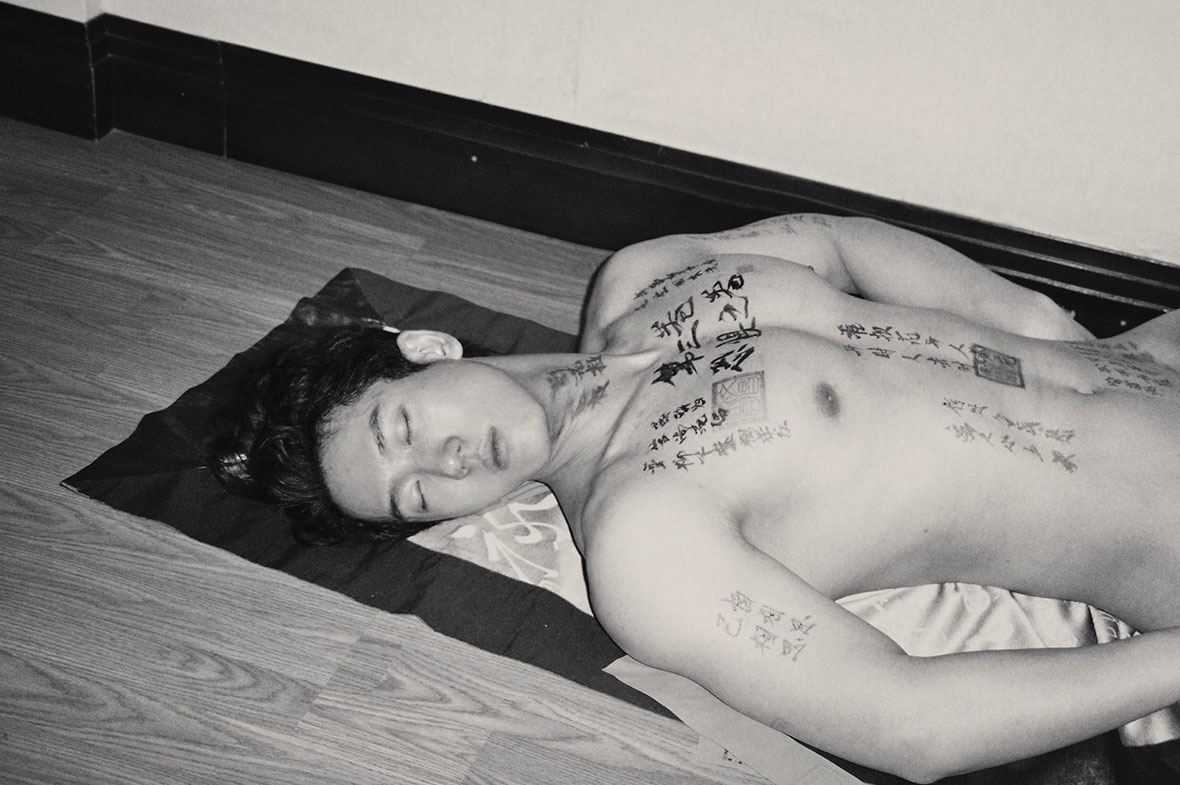
Born in 1995 in the Northeastern Chinese province of Jilin, Shengzhe began photographing the world around him with his smartphone while still in high school. He only shifted to a proper camera in his second year of university when he bought a Minolta X-700, aspiring for a vintage feel in his work. When he first began photographing erotic content, he invited his friends to model for him, but as his popularity grew on social media, more and more boys approached him, wanting to pose for his camera.
Shengzhe’s university graduation project was to create a photo book, a concept he took with him and developed further after leaving university. “I can’t be idle. After I graduated, I wanted to find a medium or platform where I could continue my ideas,” he says. The book idea developed into an annual magazine: in 2019, he published the first issue of Millennium Magazine.
圣喆于 1995 年出生于东北吉林。他从高中时期便开始用智能手机拍摄周围世界。大二那年,他买下一台美能达 X-700 相机,希望拍一些复古风的作品。圣喆第一次拍情色照片,当时的模特还是他身边的朋友。后来,随着在社交媒体上人气增长,越来越多男孩主动找他,想要出现在他的镜头下。
圣喆的大学毕设作品就是一部摄影集,毕业后,他还依然延续当初的主题进行创作。他说:“我属于闲不下来的那种人。毕业后,我想找到一种媒介或平台,继续发酵这个想法。”这个想法后来衍生出为一部年刊杂志。2019年,他发行了第一期《千禧》。
Millennium’s first issue was “Human Fireworks,” a direct allusion to sexual orgasm. The theme explores fantasies related to the climax of a sexual encounter or, as Shengzhe refers to it, “the best part of sex.” The magazine collected people’s ideas around the open-ended theme with text or imagery. It did so sensually and lightheartedly, without the intention of becoming political or a vehicle for activism. “We’re not talking about sexual rights and freedom here; we’re just talking about what it’s like to have an orgasm,” he says. “After reading the magazine, I hope people will feel that sex is just a very ordinary thing, worthy of enjoyment.”
He also hopes for the magazine to have an educational value, bridging light into topics that people don’t fully understand because of the lack of information. The third issue of Millennium was meant to feature the theme of BDSM, something he thinks is particularly misunderstood in China. The content is ready, but the magazine never went to print. “We could not produce it because of a higher force,” Shengzhe laughs.
第一期杂志被定名为《人间烟火》(Human Fireworks),隐喻性的高潮,探讨与性高潮有关的许多幻想。用圣喆的话说,性高潮是“性中最美好的部分”。《人间烟火》以一种感性、轻松的方式进行叙事和刻画,表达人们关于性高潮时的想法,丝毫没有触及政治或激进的意图。圣喆说:“我们在这里不谈性权利和自由,我们只想谈论高潮是一种什么样的感觉。我希望人们看完这本杂志后发觉,性只是一件很普通的事情,值得去享受。”
圣喆还希望他的杂志具有教育意义,在观众面前揭开禁忌的面纱。《千禧》杂志第三期的主题是 BDSM,一个在圣喆看来被中国人严重误解的议题。然而,杂志却迟迟没能印刷出来。圣喆笑着说:“因为上面的压力,我们没法印。”

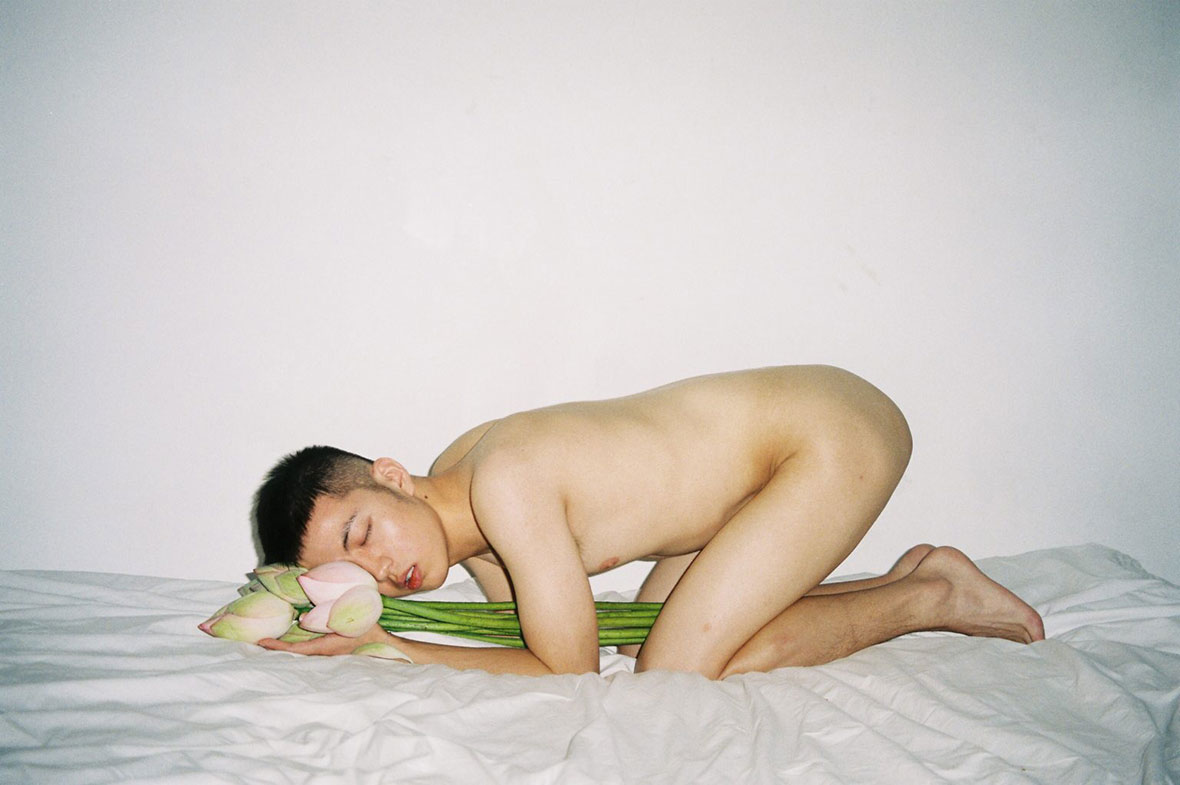
Like any artist who works on a similar subject, Shengzhe finds publishing his erotic material at home a challenge. The difficulties were such that the Millennium project came to a halt. “The LGBTQIA+ community has many difficulties to overcome in China, but this is also a driving force for me to explore and create. I hope I can maintain this curiosity and enthusiasm,” he says, adding that he’s still eager to publish Millennium and is open to collaborations outside China.
Shengzhe realizes that his subject matter is controversial and has different effects on people. “Anyone who sees my work will feel something. My style and expression are extreme. People either like it or hate it,” he says. Like Greenaway, Shengzhe doesn’t aim to entertain or amuse with his work. Instead, his goal is to beat faux morality and expand people’s boundaries by playing with their senses. Love or hate, in the end, what matters is that they feel something.
和其他类似题材的艺术家一样,圣喆发现在国内发行情色作品的挑战性很大,这也导致《千禧》杂志被迫中止。圣喆说:“LGBTQIA+ 群体在中国需要克服很多,但这也是我探索和创作的动力。我希望我能坚守这份好奇和热情。”圣喆还说,他仍希望继续出版《千禧》,并对海外合作保持开放态度。
圣喆明白,他创作的题材是有争议的,每位观众的理解都有所不同。他说,“每个人看到我的作品都会有所感受。我的风格和表达方式是极端的。人们要么喜欢它,要么讨厌它。”和格林纳威一样,圣喆的目的不是通过作品来取悦或娱乐他人。相反,他的目标是打破虚伪的道德观,通过触达观众的感官来挑战他们的边界。无论人们喜欢他的作品还是厌恶,都不重要。最重要的,能是让观众有所触动。
Like our stories? Follow us on Facebook and Instagram.
Instagram: @shengzhe__
Contributors: Tomas Pinheiro, Lucas Tinoco
Chinese Translation: Yang Young

